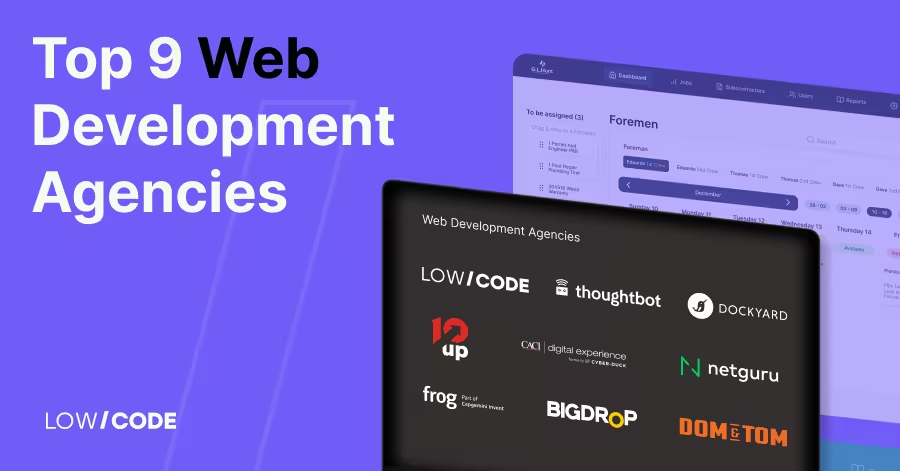What is no-code? A definition for 2025
9 min
read
Learn all about the no-code revolution! Explore its origins, practical applications, strengths, and future impact on software development.

The demand for software solutions today has far outpaced the time-consuming process of traditional coding. No-code has emerged as a game changer in this context. But what exactly is no-code? This article will look at its history, functionality, and practical applications, ranging from workflow automation to custom app development. We'll also explore its advantages and disadvantages, as well as its role in shaping the future of software development.
TL;DR
No-code is a development approach that simplifies software creation, eliminating the need for extensive coding. It's used for workflow automation, HR tasks, knowledge management, CRM, inventory, field ops, MVPs, and more. In this article, we also discuss its origins, differences between low-code and zero-code, and its projected rise in application development.
The no-code revolution: how it started
To understand the present and potential of no-code, we'll explore its origins. Traditionally, software development was the exclusive domain of highly skilled programmers and developers who meticulously wrote lines of code to create applications. This process was (and still can be) time-consuming and expensive. It also requires a deep understanding of programming languages and coding paradigms. The No-Code movement emerged as a response to these challenges, aiming to democratize software development and make it accessible to a wider audience. The roots of no-code can be traced to:
- The rise of visual development tools: The early 2000s witnessed the emergence of visual development tools that allowed users to create simple applications without writing code. These tools used drag-and-drop interfaces, enabling users to design workflows and interfaces visually, reducing the need for manual coding.
- WYSIWYG editors: The concepts of "no-code" and "WYSIWYG" (What You See Is What You Get) editing initially gained prominence in the context of web development. These approaches aimed to simplify website creation by allowing users to design web pages visually without needing to write or understand the underlying code.
- The low-code movement: The concept of low-code, which predates no-code, gained traction in the 2010s. Low-code platforms simplified application development by reducing the amount of coding required while still allowing for customization. This approach began to bridge the gap between traditional coding and codeless development.
- A growing demand for rapid solutions: In a fast-paced digital landscape, businesses increasingly required quick and agile solutions to meet the changing market demands. Traditional development cycles couldn't keep up with this need, creating a demand for quicker, more accessible development methods.
The no-code approach
The no-code method offers an alternative method for creating useful and scalable applications and marks a significant departure from traditional software development practices. No-code development does increase accessibility, but it should not be mistaken for a purely non-technical or simplistic endeavor. In fact, it entails a complex and strategic process that calls for a firm command of the relevant technology as well as strong problem-solving abilities.
No-code is not about removing technical skills from the equation; rather, it's about shifting the focus of those skills. No-code developers must possess a set of competencies, including:
- Problem-solving: No-code developers need to be adept at identifying business challenges and designing solutions using no-code tools. This often involves creating workflows, automating processes, and integrating various software components.
- Platform expertise: Each no-code platform comes with its own set of tools and capabilities. no-code developers must become proficient in using these platforms effectively, understanding their limitations, and maximizing their potential.
- Data management: Working with data is a core aspect of no-code development. Developers must know how to structure, manipulate, and analyze data to build data-driven applications.
- Integration skills: No-Code often involves connecting different software systems and services. Developers must be skilled at integrating third-party APIs and ensuring seamless interactions between various components.
- Optimization and scalability: Building no-Code applications that can grow with a business requires careful planning and optimization. Developers must ensure that their creations can handle increased user loads and evolving requirements.
No-code tools
Software platforms known as "no-code tools" enable the development of functional software solutions without the need for extensive traditional programming. Instead, each platform provides a unique environment where users can define the behavior and functionality of their applications through a visual interface.
These platforms come in various forms, serving different purposes:
No-code for app building
Some no-code platforms specialize in application development. Users can design and build a wide range of software applications, from simple utilities to complex, data-driven systems.

For example, Bubble.io offers a visual interface and a powerful backend system, allowing users to create web applications with databases, user authentication, and dynamic workflows. Bubble.io is suitable for developing applications like marketplaces, social networks, project management tools, and more.
No-code for website creation
No-code tools for website development are software platforms that allow users to create and customize websites without the need for traditional coding. These platforms provide visual interfaces and pre-built components for designing web pages, implementing complex functionality, and managing content.

Examples of such platforms include Webflow and Wix. They’re suitable for building a variety of websites, from personal portfolios and blogs to e-commerce stores and company websites.
Micro-process no-code tools
Unlike platforms where you can build entire applications, micro-process tools like Zapier don't enable you to build your own app from scratch. Instead, their purpose is to facilitate connections between the apps you already use. It enables apps to exchange information and trigger actions.

No-code for data management
Some No-code tools excel in data management and organization, allowing users to create powerful databases and data-driven applications without extensive coding. These tools are ideal for projects where structured data plays a central role.

Airtable is a good example of a no-code platform for data management. It combines the flexibility of a spreadsheet with the functionality of a database, enabling users to create and manage structured datasets. Airtable is valuable for tasks such as project tracking, content management, and inventory management, where structured data is crucial.
No-code automation tools
Some no-code tools focus on streamlining and automating tasks and workflows. These tools let users create automated processes, saving valuable time and reducing the need for manual labor.

Many no-code platforms, including some mentioned earlier, offer automation capabilities. For example, Bubble, Zapier, and Glide are excellent examples of tools that allow users to automate tasks and processes. These platforms make it possible to create custom workflows that enhance productivity and free up valuable resources. Whether you're managing data, automating communication, or optimizing user experiences, no-code automation tools provide the means to do so with ease.
How no-code works
- Visual modeling: No-code platforms start by providing a visual modeling environment. Users create the structure and layout of their applications by dragging and dropping elements onto a canvas. Each element represents a component or function of the app, like buttons, forms, or data tables.
- Metadata generation: As users design their apps visually, the no-code platform generates metadata that defines the properties, relationships, and behaviors of the app's components. This metadata is crucial because it serves as the blueprint for the application's functionality.
- Code generation: Once the visual design and metadata are in place, the no-code platform employs code generation algorithms. These algorithms automatically translate the metadata into code that runs on the backend. This generated code includes the logic for handling user interactions, data storage, and process automation.
- Data management: No-code platforms often include built-in database management systems. When users create data tables or define data structures in their apps, the platform generates the necessary code to create and manage databases. This ensures that data is stored, retrieved, and manipulated as needed.
- Event handling: User interactions, such as button clicks or form submissions, trigger events in the app. No-code platforms handle event management by generating code that specifies what actions should occur when specific events take place. For example, when a user clicks "Submit," the platform-generated code defines how the data is processed and stored.
- Integration connectors: No-code platforms offer pre-built connectors and APIs to external services and systems. These connectors simplify the integration process. When users connect their apps to external services (like payment gateways or email providers), the platform-generated code ensures that data can flow seamlessly between the app and those services.
- Automation engine: no-code platforms include an automation engine that manages workflow automation. Users can define rules and conditions for automating tasks, such as sending notifications or updating records. The platform-generated code orchestrates these automated actions, ensuring they occur as specified.
- Deployment and hosting: No-code platforms typically handle the deployment and hosting of the generated applications. They provide the necessary server infrastructure to host the app on the web or mobile devices, ensuring it's accessible to users. This includes managing server security, updates, and scaling as the app grows.
- Runtime environment: The generated code runs within a runtime environment provided by the no-code platform. This environment interprets and executes the code, allowing the app to function as intended.
Difference between no-code, low-code, and zero-code
It's essential to understand the distinctions between these three development approaches.
- No-code: No-code platforms allow users to create applications with minimal or no traditional coding. Users design applications through visual interfaces, automations, and pre-built components. While the emphasis is on a code-free experience, some no-code tools also allow users to incorporate limited customizations through code when necessary.
- Low-code: Low-code platforms also streamline application development but offer more flexibility for custom coding. Users can employ low-level coding for further customization or to include complex features.
- Zero-code: Zero Code goes a step further by emphasizing complete automation, where users create applications without any manual coding or configuration. It typically relies on artificial intelligence and pre-built templates for rapid app creation.
Pros of no-code
- Speed: No-code tools accelerate application development, allowing businesses to respond swiftly to market changes and customer demands.
- Cost-efficiency: With reduced development time and resources, no-code can be more cost-effective than traditional coding approaches.
- User-centric: No-code tools prioritize user experience, making it easier to design applications that align with user needs and preferences.
- Rapid prototyping and iterations: Users can quickly prototype and test ideas, helping refine concepts before committing to full-scale development.
Cons of no-code
- Limited customization: No-code platforms may have limitations when it comes to highly specialized or unique functionalities.
- Scalability challenges: Some no-code apps may face scalability issues as they grow, requiring more advanced solutions.
- Vendor lock-in: Users can become reliant on specific no-code platform features, potentially making it challenging to switch to other development methods.
- Complex projects: Extremely complex applications may still require custom coding, making no-code less suitable for certain use cases.
What you can build with no-code
No-code development opens up a world of possibilities for businesses, enabling them to create custom applications tailored to their specific needs. Here are some examples of solutions that can be built with no-code:

- Workflow management apps: Create applications that automate intricate processes, offering managers visibility, reducing errors, and boosting productivity throughout the organization.
- Custom CRMs: Build tailored Customer Relationship Management (CRM) systems that enhance customer interactions, improve lead tracking, and effectively manage client relationships.
- E-commerce solutions: Create customized e-commerce platforms to sell products or services online. No-code tools enable businesses to design and launch online stores with features like product listings, shopping carts, payment processing, and order management.
- Project management tools: Build project management apps that help teams organize tasks, collaborate on projects, and track progress. No-code platforms enable users to customize project workflows and adapt them to specific project needs.
- Booking and reservation systems: Create booking and reservation apps for various industries, including hospitality, healthcare, and fitness. These apps can handle appointment scheduling, resource management, and customer bookings.
- Customer support portals: Develop customer support applications that enhance customer service by providing self-service options, ticketing systems, and knowledge bases.
- Marketing automation: Utilize no-code tools to create marketing automation workflows for email marketing, lead nurturing, and customer engagement.
Keep in mind that this is not an exhaustive list! With no-code, the possibilities are virtually limitless.
The future of no-code
No-code technologies are ushering in a new era of software development. In late 2021, Forbes highlighted the disruptive influence of no-code and low-code tools in the software development industry, given the significant seed funding secured by platforms like Webflow and Bubble.
This shift is undeniable; No-code platforms have emerged as the next major force in software development. Gartner has projected that, by 2025, 70% of new applications will be created using low-code or no-code platforms.
Over the coming years, organizations of all sizes, as well as individual innovators, will increasingly turn to these platforms to bring their creative visions to life. It's an era where the focus shifts from the intricacies of coding to the forefront of creativity, problem-solving, and innovation. Businesses will adapt and innovate more quickly, unburdened by the constraints of slow, traditional coding.
As we look ahead, it's evident that no-code platforms will only continue to evolve and expand in quality and capabilities, while their adoption grows with more and more individuals and businesses turning to them.
Join the future with no-code too! Reach out to us today for expert consultation and a detailed quote tailored to your requirements. -Book your free discovery call-
Created on
September 17, 2023
. Last updated on
May 7, 2025
.

FAQs
What is the meaning of no-code?
Is no-code a skill?
What can no-code do?
What is an example of no-code automation?
Is no-code the future?







%20(Custom).avif)








